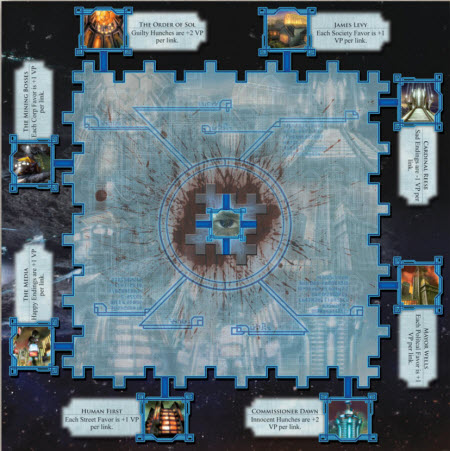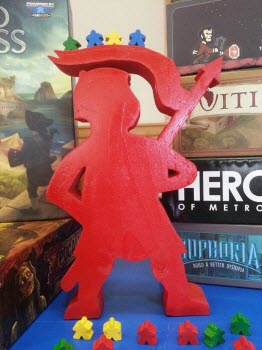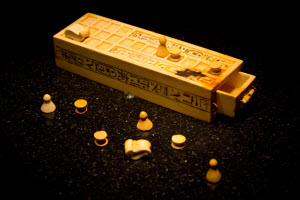
An ancient Senet board.
Once upon a time, the gaming world was a barren place. Players enjoyed rudimentary pawns, discs, and tokens to track what was going on in their game, for it was a simpler time, with simpler games, and such things sufficed.
Over the centuries, unit tokens developed and evolved. Sometimes it was to differentiate one unit to the next, such as in Chess or other battlefield games. Other times it was a means to create a unique player piece to connect with, as in the case of Monopoly. (I always preferred the car myself.) And lo’, for many years longer that also sufficed. . .
In the present era, though, it isn’t quite as easy. Games have evolved a lot in a very short time period, and, well, we’ve gotten a bit spoiled. Games don’t necessarily need bright shiny pieces and intricate units to be enjoyable – take your pick from the cornucopia of cube-pushing Euros as evidence of that. Nor do amazing-looking components necessarily make it a great game. You can have the most detailed array of pieces imaginable, but if the game lacks substance, it can be all for naught.
As the gaming world continues to progress it’s become evident that, for many, how a game looks and feels has become as important as how it functions. All of a sudden, all those little pieces matter. There are loads of choices in the gaming world, and only so much time – not to mention money – to go around. It’s entirely likely that what a game includes will be part of your decision-making as to whether you’ll want to play or purchase it.
What follows are my personal five favorite gaming component areas:
#5. Building Pieces
Two of the games that I enjoyed regularly when I was young was Mouse Trap and The Grape Escape. The thing was, I realized later on, was that it wasn’t the games themselves I liked. Both Mouse Trap and The Grape Escape are essentially dolled up Roll And Move games, hidden underneath a pile of plastic gears, cranks, and other Rube Goldberg-type pieces. Rather, it was setting them up that I looked forward to the most.
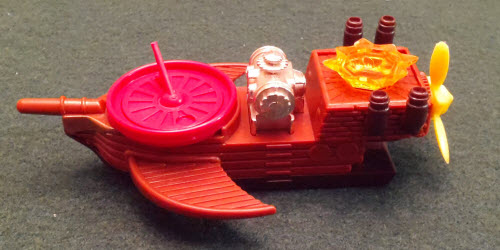 This makes sense, as I’m both a natural tinkerer and one prone to fidget. It’s not an attention thing; I just like that tactile feeling of taking one set of things and modifying them into another. Whether it was blocks, Legos, or Ikea furniture, I’ve always liked building and assembling. So, I appreciate games where that is visually represented, even if the process of doing so is very minor, or even if it’s there simply for thematic purposes.
This makes sense, as I’m both a natural tinkerer and one prone to fidget. It’s not an attention thing; I just like that tactile feeling of taking one set of things and modifying them into another. Whether it was blocks, Legos, or Ikea furniture, I’ve always liked building and assembling. So, I appreciate games where that is visually represented, even if the process of doing so is very minor, or even if it’s there simply for thematic purposes.
Examples of this would include reassembling the airship in Forbidden Desert or stacking bamboo shoots in Takenoko. These games easily could have depicted these actions in a 2-D environment like most games, and that’d be fine. But having that extra dimension appeals to my younger self even now.
The caveat to this one is that I don’t want the manipulation of those components to hinge on me actually being able to win (i.e. Jenga). I just like these pieces here for the tactile experience, not a requirement for victory. If I wanted that, I’d just pull out Mouse Trap again. Granted, not a lot of games do this, for obvious cost reasons, and so I appreciate it all the more when they do.
#4. Interesting Resources
It’s no big secret that I’m a big fan of Euro games, and I can move around little wooden blocks with the best of them. Some groan at the thought, though. I’ve had more than one occasion where I’ll be explaining how each of the different-colored-but-otherwise-identical cubes correspond to all of various resources, and watch the light go right out in that person’s eyes.
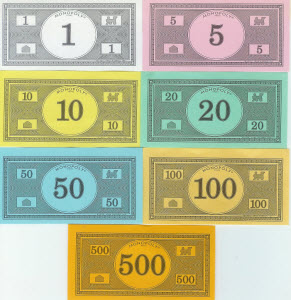
I was always the damn banker.
This doesn’t happen with me. I have a much harder time pretending that I am another person more than pretending that the blue barrel is Indigo and the brown one is Coffee (which is why I don’t delve into many RPGs). However, I completely understand someone’s reticence if a game – especially a resource game – doesn’t entice them. Resource games can be incredibly dry affairs if there isn’t something that holds your attention, and one of the best ways do that is to make the game’s commodities more visually appealing than the status quo.
For a long time your choices were either paper money or cubes, but designers in recent years have experimented with different ways to represent a game’s resources. To me, this is done in one of two ways. The first is to simply make the components stand out more, and one game that immediately comes to mind is Zong Shi. The game’s main ingredient resources are still basically colored tiles, but they have bright colors and an impeccable quality to them that make you appreciate the game’s theme of being master craftsmen even more. The deluxe version of Euphoria also does this, with realistic-feeling gold, brick and stone pieces.
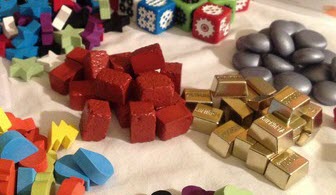
Gold!
The other way is to take previously seen units and do something new. Most have seen a worker meeple before, but in Keyflower, for instance, meeples are both your workers and your currency. In Rampage, the meeples aren’t even people; they’re just food.
Similarly, Glass Road takes the resource acquisition idea you’d expect from a Euro game and takes it for a spin. Literally. Glass Road utilizes a unique resource wheel mechanic that avoids making it feel like just another European-based game about getting natural resources.
#3. Customized Dice
I am a terrible, terrible dice roller. I only lasted as long as I did in Risk over the years because I would sit on territory cards as long as possible and generate huge armies – which I’d need. In fact, I have such bad luck when it comes to rolling a die or flipping a coin that I once built an entire Magic deck based solely around that concept. (While fun, it generally does’t go well.) Consequently, you would think that I detest games of heavy luck.
To be fair, you wouldn’t be wrong. (I am still a Tactician after all.) I don’t get the same level of enjoyment out of heavy dice games that many do. However, that’s because of the luck factor, not because of the dice.

Behold the Quake Dragon
I actually like dice a lot, and customized dice even more so. Probably more than I should, since they’re always out to get me and all. Still, I’m particularly positive on games that center around custom dice usage such as Quarriors and Castle Dice, because such games are based heavily around utilizing the different probabilities that their unique dice generate.
That said, I’m less wowed by dice of different materials, sizes, or games that have a simple symbol translation – replacing one or more normal sides with symbols that effectively mean the same thing – but I still appreciate them if it fits the theme of the game, since it’s something they don’t necessarily have to do.
#2. Unique Board Interaction
The first board game I got excited about once the allure of Candy Land, Monopoly, Clue, and Risk wore off was the game Survive!. Aside from the sheer enjoyment I got sending my siblings and relatives into the maws of a sea serpent, I loved the idea of this randomly-generated island that slowly sunk into the ocean. Tiles had to be revealed in a pseudo-concentric pattern, and each revealed island piece did something unexpected. This was so different than any game I had experienced before, in part because I had never dealt with a board that wasn’t the same every time.
Survive was one of the first real experiences I had with a non-classical game, and it stuck with me for a variety of reasons. One of which was that unique board interaction. As a result, I’m still highly affectionate to games that have the board do something beyond being just the setting’s backdrop. This could be something like having to compile the puzzle-like conspiracy grid in Android, or the moving and interlocking gears of Tzolk’in.
And then there’s the 90’s game Key to the Kingdom, which has the game board fold in on itself and was triggered by jumping into a pair of holes in the board.
Also, while it’s more of a tableau area than a board, I also really appreciate the transparent overlay card system in Gloom, where you can play cards on top of one another to cause different effects to happen, and the abilities may or may not stack depending on what’s visible.
Can these interactions be gimmicky? Sure. However, they also illustrate a level of creativity in exploring design space that many simply take for granted, and innovation is part of the fun in gaming.
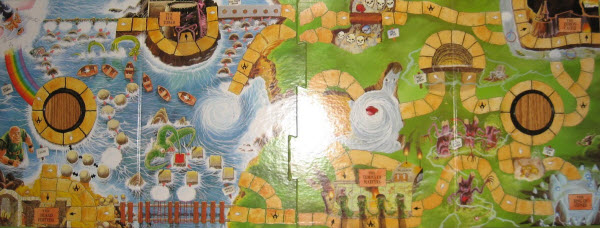
A fully unfolded Key to the Kingdom board.
#1. Customized Meeples
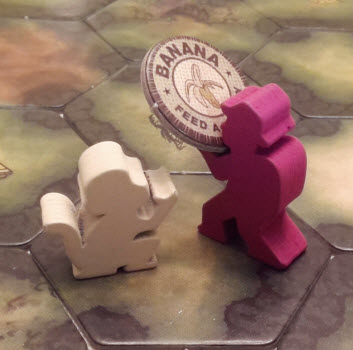
Monkey still want Banana!
Yep, in the epic gamer divide between meeples and minis, I am a meeples person. Don’t get me wrong, I have extremely high regard for the folks who design, sculpt, produce, and/or enjoy miniatures, and there’s no denying the supurb levels of craftsmanship that exists in the market…but it’s just not my scene.
To me, miniatures are present to be visually appealing and to accentuate the game they’re taking part in. And, frankly, so long as the male sculptures don’t look like they’re on steroids and the female ones are wearing functional clothing/armor, all the power to those who enjoy them.
The thing is, in many ways, good miniatures can steal the show away from the board game itself, and that’s what I’m sitting down for. Meeples, on the other hand, are these little nameless, faceless units of wood that enhance my board gaming experience. I get to give them life, give them character. Whether I’m playing with Bill the Pony in Wizard’s Brew, passing the first player token around in Chicken Caesar, making the Abe Lincolns dance in Pixel Lincoln, am running away from…pretty much everything in Relic Expedition, or contemplating how just about anything from this Kickstarter could accentuate my other games, meeples are a fun and inviting aspect to the board game hobby.
In my mind there is no greater representation of what it means to be a tabletop gamer than to sit down with a board, some friends, and a host of little wooden beings. They are the gatekeepers of our realm, and through the power of imagination we can have them wear any number of hats to suit our gaming needs.
Well, imagination, and a good jigsaw.
![]()
Speaking of favorite game components, we’ve decided to go ahead and give some away. This month’s Indie Spotlight game is Euphoria, and those fabulous Deluxe edition resources are too good to keep bottled up. So we’re giving a set of them away. Whether they’re for your own copy of Euphoria or something else is up to you. Click here to find out how you can enter and win a copy of them!
Photo Credits: Senet board by Wikimedia; Monopoly Money by World of Monopoly; Euphoria components by Stonemaier Games; Quake Dragon by Wikia; Android board by Fantasy Flight Games; Key to the Kingdom board by BoardGameGeek.

